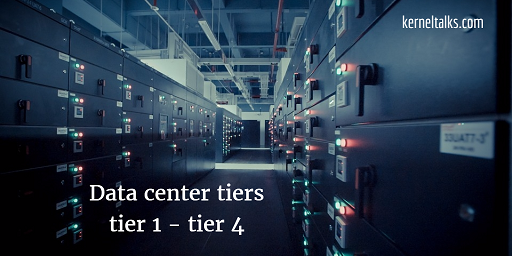Understand and learn about data center tier. The article explains the data center standardization matrix: tier 1 to tier 4 along with its eligibility criteria.

Most of our readers are system administrators and surely come across term call data center tiers in their sysadmin life. This article will walk you through what is data center tiers? Different types of data center tiers, what is tier 1, tier 2, tier 3, and tier 4 data center? Which tier data center have maximum availability? etc.
All these might be interview questions for system architects at the beginner level. As a sysadmin its always good to know data center tiers so that you are well verse with your company infrastructure and can decide if that can really deliver on SLAs defined in your environment.
Without further delay, lets start with our topic.
What is data center tier?
Datacenter tier is the standardization matrix that defines overall performance, availability, fault tolerance capability, operating environment of a data center. It defines how the data center is fault-tolerant, how it can sustain to failures of various components, power, connectivity links, etc. It defines availability being offered for hosted servers.
Basically data center tier helps customers to determine which tier is best suitable for their application depending on the SLA requirement and data critical index they have. Mission-critical services should be hosted under a higher tier data center whereas less critical data should be hosted in lower-tier data centers. Obviously cost is another factor here too. As you go on high with tier, cost increases for hosting.
Different data center tiers
There are 4 data center tier standards defined by Uptime Institute. They are as below :
- Tier 1: Non-redundant capacity and single power, connectivity distribution
- Tier 2: Tier 1 feature + redundant capacity
- Tier 3: Tier 2 features + Multiple independent power, connectivity distribution + onsite energy production system
- Tier 4: Tier 3 features + All components are fault-tolerant, continuous cooling equipment.
A detailed list of requirements to be fulfilled by the data center to be eligible for specific tier is available here.
Data center tier deciding factors :
Datacenter to be eligible for certain tier it should complete certain criteria (as we saw above). There are many factors that affect/help in achieving those criteria. These factors are as below –
- Datacenter design, location
- Mechanical infrastructure design
- Technology infrastructure design
- Electric power distribution
- Cables distribution
- Network and internet connectivity distribution
- Fire protection
- Security in terms of soft security and physical security controls like biometric etc
- Energy production, use, efficiency
- Waste management
- Environmental control and effects
- Cooling management
- Capacity management
Accepted downtime and availability tier wise
- Tier 1: 99.671% uptime, 28.8 hours downtime per year
- Tier 2: 99.749% uptime, 22 hours downtime per year
- Tier 3: 99.982% uptime, 1.6 hours downtime per year
- Tier 4: 99.995% uptime, 26.3 minutes downtime per year
That’s all I have to share with you about data center tier standards. Feel free to point out mistakes, suggestions, feedback in the comments section below.
“I visited your web site today and found it very interesting and well done. I can tell you have put a lot of work into it.”